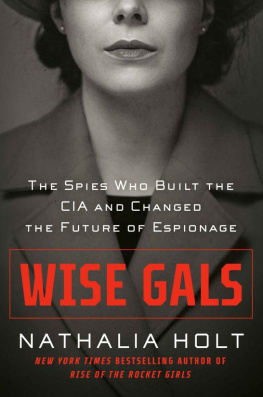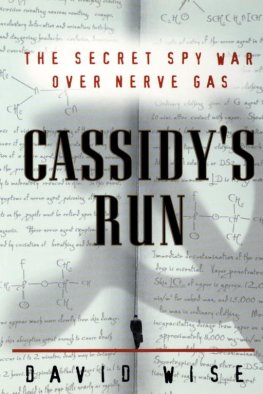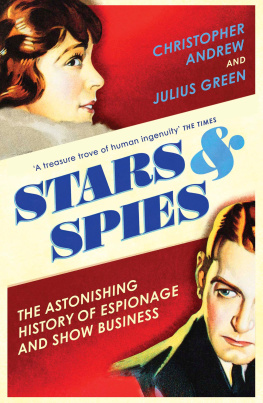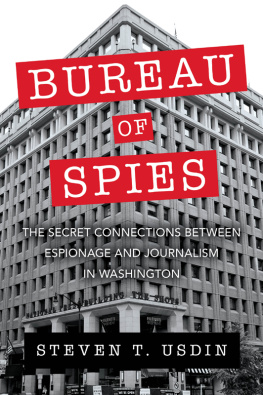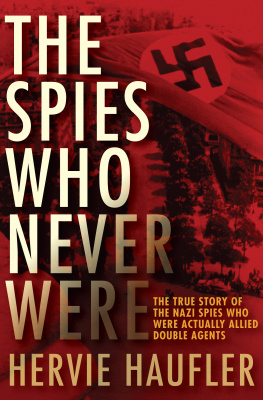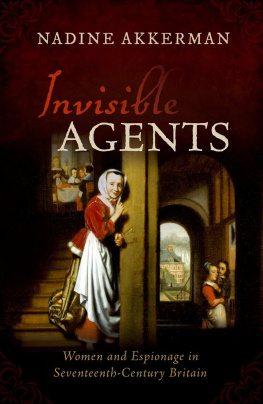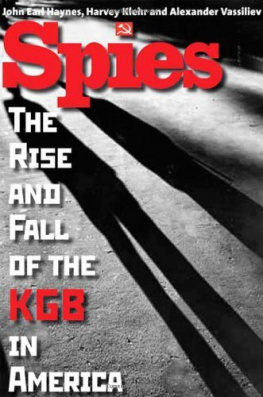ALSO BY NATHALIA HOLT
The Queens of Animation: The Untold Story of the Women Who Transformed the World of Disney and Made Cinematic History
Rise of the Rocket Girls: The Women Who Propelled Us, from Missiles to the Moon to Mars
Cured: The People Who Defeated HIV

G. P. Putnams Sons
Publishers Since 1838
An imprint of Penguin Random House LLC
penguinrandomhouse.com

Copyright 2022 by Nathalia Holt
Penguin Random House supports copyright. Copyright fuels creativity, encourages diverse voices, promotes free speech, and creates a vibrant culture. Thank you for buying an authorized edition of this book and for complying with copyright laws by not reproducing, scanning, or distributing any part of it in any form without permission. You are supporting writers and allowing Penguin Random House to continue to publish books for every reader.
Library of Congress Cataloging-in-Publication Data
Names: Holt, Nathalia, 1980- author.
Title: Wise gals: the spies who built the CIA and changed the future of espionage / by Nathalia Holt. Other titles: Spies who built the CIA and changed the future of espionage
Description: New York: G. P. Putnams Sons, [2022] | Includes bibliographical references and index. |
Identifiers: LCCN 2022019091 (print) | LCCN 2022019092 (ebook) | ISBN 9780593328484 (hardcover) | ISBN 9780593328491 (ebook)
Subjects: LCSH: United States. Central Intelligence AgencyHistory. | Women intelligence officersUnited StatesBiography. | Intelligence officersUnited StatesBiography. | Women spiesUnited StatesBiography. | SpiesUnited StatesBiography. | Intelligence serviceUnited StatesHistory20th century. | United States. Central Intelligence AgencyOfficials and employees. | Discrimination in employmentUnited StatesHistory20th century.
Classification: LCC JK468.I6 H63 2022 (print) | LCC JK468.I6 (ebook) | DDC 327.1273009dc23/eng/20220518
LC record available at https://lccn.loc.gov/2022019091
LC ebook record available at https://lccn.loc.gov/2022019092
Cover design: Sandra Chiu
Cover image: Shelley Richmond / Trevillion Images
Interior art: World map Oleksandr Molotkovych/Shutterstock.com
Book design by Kristin del Rosario, adapted for ebook by Maggie Hunt
pid_prh_6.0_140847954_c0_r0
For the women who toil,
invisible,
invaluable,
for Laurie
Put yourself behind my eyes
and see me as I see myself,
for I have chosen to dwell in a place you cannot see.
JALL AL-DN MUAMMAD RM
CONTENTS
AUTHORS NOTE
The Wise Gals are no longer with us to tell their stories, and yet they still speak. This work of nonfiction was researched thanks to the materials they left behind, which include diaries, letters, interviews, reports, memos, scrapbooks, and photographs. In addition to these sources, the Central Intelligence Agency has released primary documents about the careers of these women and the challenges they faced. All the work published in this book is declassified and was obtained through the Freedom of Information Act.
A large portion of this book is credited to the CIA officers, both retired and active, who contributed their stories and memories. Just like the work these men and women perform, their contributions to the book remain anonymous. For this reason, their names appear as redacted in the source notes, and their own stories, while worthy of telling, have mostly been left out.
Firsthand accounts of historical events are often slanted by those who have lived through them. To limit this, I have used material from archival sources, acquired from multiple countries, to ensure that the material I obtained through these interviews is factual. Occasionally, material obtained from an interview was unable to be supported through outside sources. In these instances, Ive weighed other evidence, and carefully checked dates and timing, when deciding whether to include these portions within the book. When Ive chosen to include these firsthand histories without supporting documentation, Ive noted the instance in the endnotes.
The thoughts and feelings of individuals in the book were obtained through their personal materials and author interviews with those who knew them. All quoted material is obtained directly from primary sources and credited in the endnotes.
This is the kind of book the Wise Gals could not have anticipated would ever be written. In their later years, they watched as their male colleagues became the subjects of multiple biographies, while their lives and accomplishments remained undocumented. Sadly, their stories could not have been told while the women were still with us. If living, neither the identities of the women, nor their work within the agency, would have been disclosed by the CIA. It is only in death that the full measure of their accomplishments can be revealed.
ADDY HAWKINS
LIZ SUDMEIER
MARY HUTCHISON
JANE BURRELL
ELOISE PAGE
NOVEMBER 1953
A small group of women gathered together just a few blocks from the White House to contemplate the dismal future of American intelligence. They had spent the past decade forming the fledgling American espionage enterprise known as the Central Intelligence Agency, breaking new ground for women in the workplace by working alongside men in dangerous, important operations. Theyd played an integral part in gathering the intelligence that had won World War II for the Allies, and now they were on the front lines of the Cold War, spreading their network of spies across the world. But at this moment, these female founders were taking a rare opportunity to look inward.
And what they saw made them angry.
Eloise Page wasnt the kind of woman who was prone to emotional outbursts. Her friends would tell you that when she was upset, her demeanor was usually icy rather than explosive. She had a firm sense of right and wrong, and she never hesitated to reprimand those who crossed a line. Yet on this unusually balmy day in Washington, D.C., her temper was fiery.
For the past few months, Eloise and a group of twenty-two of her female colleagues at the CIA had tackled a seemingly impossible goal: to strip away the inherent sexism that plagued the institution they loved. Women were doing the same work as their male counterparts, Eloise and her colleagues argued, but they werent getting the same pay or recognition as the men they worked alongside each day. That had to change. To accomplish this, they had carefully documented the experiences of women at the agency over the course of years. The daring missions. The enormous responsibility. These women had given everything to safeguard Americas security. In fact, some of their colleagues had even given their lives.

